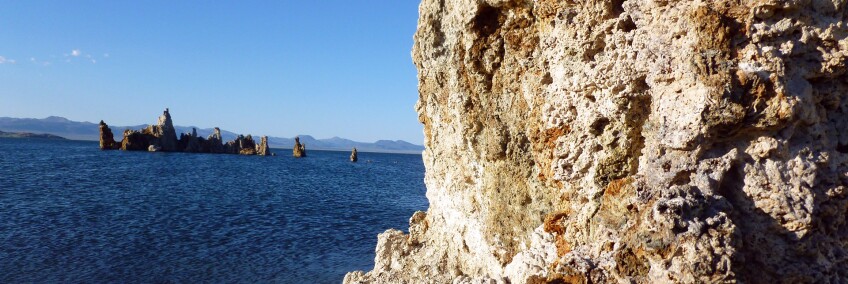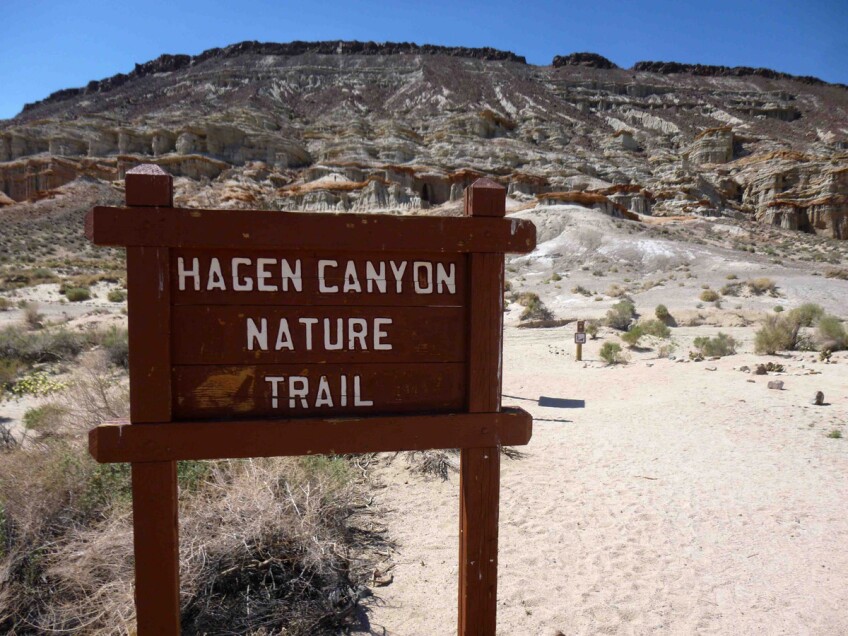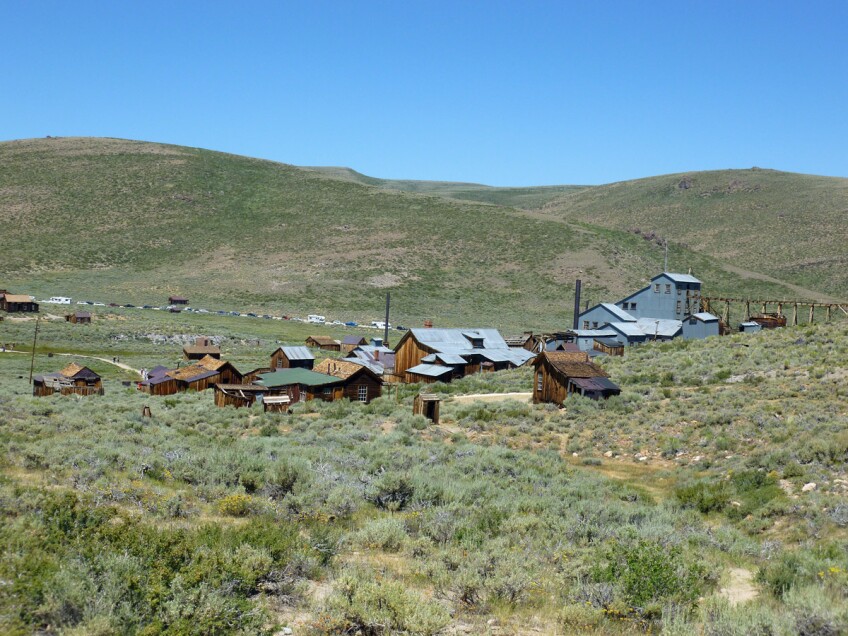Where to Find State Parks in the Central Valley & Eastern Sierra

Heading up north in August or September to escape the summer slog of Southern California? Waiting for the temperatures to cool off for a road trip to the Mojave or the Central Valley a little later this year?
Or maybe you’re looking for an adventure somewhere snowy this winter?
One of the best ways to explore Kern, Inyo and Mono counties is by hopscotching through the state parks of our great golden state.
There’s no time like the present to plan your trip. Book your adventure in advance at the newly-launched “Reserve California” so you don’t miss out on that primo campsite.
But our California state parks aren’t just for camping. They’re not even just for hiking!
In fact, at many of our state-managed parks, you’ll also find plenty of history, scenery and nature — all of which you can explore on foot, by boat and even by snowmobile.
And if you’d rather not sleep through the “nightlife” of some of these California treasures, nocturnal types can attend special programs to experience the dark skies, shadowy creatures and maybe a jump scare or two.
Whether you’re interested in unearthly landscapes, endangered wildlife, the ghosts of a bygone military brigade or the beautiful ruin of abandoned mining camp that once struck gold, here are the five best state parks that are worth the drive to our neighboring counties to the north.
1. Fort Tejon State Historic Park, Lebec (~90 minutes north of LA)
If you go at the right time, hiking your way through this mini ghost town of barracks and mess halls and other military facilities can seem particularly ghostly. And that’s not just because of the buried body of Peter Lebeck — who, according to lore (and his headstone), was killed by a grizzly bear. His epitaph had been carved into one of the 400-year-old valley oak trees, but now a more permanent grave marker memorializes this mysterious figure. Fort Tejon also houses the graves of six enlisted men in a small military cemetery — all of whom died sometime between 1855 and 1864. In addition to serving as the western terminus of the failed Camel Brigade experiment, Fort Tejon was notable as one of the headquarters of the First US Dragoons and regimental band and features a looped trail around the old fort parade grounds, where you can even explore the old barracks that were converted into a museum. Along the parade route, you’ll find kitchens, messhalls and outhouses, though the Officer's Quarters and the bakery have been reduced down to their foundations. Other adobes, like the Orderly's Quarters, have been fully restored to reflect a historically accurate portrait of the period. Although it may seem like it was all music and merriment during Fort Tejon's heyday, apparently prisoners were locked up in poorly ventilated, dark, freezing cold jail cells — that is, until they figured out how to escape them in the middle of the night. The fort was abandoned for good in 1864 — and what you can experience there today is actually only half of the original US Army outpost, the other half having been obliterated by the I-5 Freeway and Tejon Ranch. Special events abound here, including Civil War reenactments, the annual “Death of Peter Lebeck” candlelight ghost tours and other living history programs presented by the Fort Tejon Historical Association.


2. Tule Elk State Natural Reserve, Buttonwillow (~2 hours north of LA)
Just west of the I-5 Freeway and north of the Taft Highway, near the Elk Hills of western Kern County, there’s a small herd of tule elk that were protected from the brink of extinction in 1932, having been over-hunted throughout the 18th and 19th centuries. The elk that currently reside at this state natural reserve were transplanted here from elsewhere in California, but they’re right at home amidst the foothills and grasslands of the San Joaquin Valley, where the deer and the antelope really do play. In fact, elk are the second-largest members of the deer family and the tule (pronounced TOO-lee) is one of three surviving subspecies of elk, one that’s endemic to California. The herd at this 953-acre preserve is limited to an ideal size of only 30 to 35 – but since they’re a breeding population (whose mating season is during the summertime), some elk get relocated to nearby open spaces (like Carrizo Plain and Wind Wolves) when the herd gets too big for the space. The park is only accessible at the Visitor Center at its entrance, where you can whip out a pair of binoculars on a viewing platform in hopes of catching a glimpse of the elk as well as of raptors and other birds who frequent this stopover along the Pacific Flyway. For a closer look, join a ranger-led “Auto Safari” tour on the fourth Saturday of the month. If you visit another time, you’re pretty much on your own with the interpretive exhibits. Enjoy the solitude.

3. Red Rock Canyon State Park, Cantil (~2 hours north of LA)
As you head north out of Los Angeles County and start to explore the beginnings of Kern County, our neighbor to the north, you first hit the Sierra Nevada in the westernmost area of the Mojave Desert. It’s a sparse drive up Highway 14, the so-called “Aerospace Highway,” after you’ve veered off the 58 and left the Mojave Spaceport in your dust. Among the unincorporated communities up there, between the turn-of-the-last-century railroad town of Cantil and the watering hole of Indian Wells, lies an expansive California state park with stunning displays of red rocks, sites of paleontological significance and — if the weather cooperates — colorful wildflowers. The first state park to be designated in Kern County, Red Rock Canyon (not to be confused with Red Rock Canyon Park in the Santa Monica Mountains, Red Rock Canyon in Nevada or Red Rock State Park in Arizona) is one of those "anything goes" hiking destinations. There, you can meander aimlessly and explore the red- and orange-colored desert cliffs to your heart’s content. But if you prefer a little more structure, the Hagen Canyon Nature Trail in the portion of the park that’s west of Highway 14 is an accessible, easy way to wander along through a flat alluvial plain and among the buttes that served as landmarks for the 20-mule team freight wagons and the pioneers who'd survived their passage across Death Valley. The scenery will look familiar to anyone who's seen Jurassic Park or any number of westerns that have been shot here. As you scan the visual panorama, look for small wildlife underfoot — like lizards, mice and ground squirrels — as well as hawks and other birds of prey that snack on those little critters. A popular way to enjoy Red Rock is overnight camping as well as off-roading — and there are plenty of options for both in the part of the park that’s across Highway 14 in its eastern environs.


4. Mono Lake Tufa State Natural Reserve, Lee Vining (~5 hours north of LA)
For an other-worldly, interplanetary experience, head to the unearthly formations of Mono Lake, just east of the Tioga Pass entrance to Yosemite National Park. This ancient lake — one of the oldest in North America — is where sun, sea and mountains meet, in a simple ecosystem where geology evolves before your very eyes. Once-submerged tufa towers at the south end of the lake are now exposed by the receded water line and new tufas arise from the bottom of this inland sea. Water levels rise with the melt of the nearby mountaintop snow pack. Phalaropes migrate to Bolivia; ospreys nest. Brine shrimp thrive in the salty water and alkali flies scatter along the shore. You walk the Mono Lake Trail from the town of Lee Vining to the Mono Basin Scenic Area Visitor Center, where you can take a loop around a nature trail and then continue your hike all the way to the Old Marina in less than three miles. Mono Lake Committee provides walking tours of the South Tufa area in conjunction with the state park, the Eastern Sierra Interpretive Association, the US Forest Service (given its proximity to Inyo National Forest) and the National Park Service — but one of the best ways to see the tufas is actually from above them. So, hike along the top one of the most recent volcanoes of the Eastern Sierra, Panum Crater. Or, hop on a canoe, explore the lake from its surface and get the best vantage point for some excellent birdwatching. Guided canoe tours are available through Labor Day, or bring your own kayak. You’re even welcome to swim in the incredibly buoyant lake — but although there are no fish in the water, there are plenty of other “submerged obstacles” (not the least of which are some of those new mineral deposits from the natural springs that feed the lake).


5. Bodie State Historic Park, Bridgeport (~6 hours north of LA)
The former gold mining camp of Bodie, now a state park in the Eastern Sierra near the Nevada border, is probably the best-preserved example of a “Gold Rush”-era ghost town. And it’s also one of the biggest. In fact, Bodie is full of old buildings that were abandoned in 1942 and preserved in the 1960s in what was then their current condition, forever frozen in a state of “arrested decay.” Although a fire in 1932 destroyed 90 percent of the boomtown, which once had over 2,000 buildings and a population upwards of 10,000, you can get a good hike in just by wandering the streets and climbing up the hill. Beware of uneven walkways, low-clearance, disembodied doorways and free-range cattle roaming through the park after finding a break in the fence. Time your visit right and you can jump on a ranger-led guided tour of the old stamp mill, where gold was once extracted from quartz and turned into bars. The machine shop equipment is still in place in the dark and dusty interior, its floors warped by water (presumably from the two fires it survived). Stamp mill tours are conducted at 11 am and 1 and 3 pm through September 8. Other special event highlights include nighttime ghost walks and photography workshops hosted by The Bodie Foundation. The Museum/Visitor Center is closed from mid-October to mid-May, but Bodie itself is open all year. It can get buried under snow in the winter season — which makes it a great destination for snowshoeing and cross-country skiing. Since even four-wheel drive cars can get stuck in deep snow and no towing services are available, your best bet for arriving to the site is by snowmobile.










